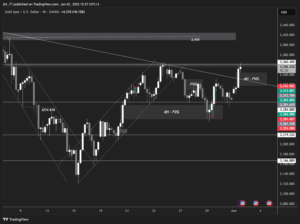Global gold prices are rising at this moment in trading today, as attention shifts to key US inflation reports due out this week, which could provide more insight into the pace and size of interest rate cuts by the US Federal Reserve this year.
Helping to pull prices lower was profit-taking by investors, taking advantage of the gains of the yellow metal, which rose by about 2.9% last week, following weak US jobs data, supporting bets on interest rate cuts this year.
US producer price index data is due out today at 3:30 PM Saudi time, followed by consumer price index data on Wednesday. Consumer price index data is expected to show core inflation rising 0.3% month-on-month in April, down from 0.4% the previous month, bringing the annual rate to 3.6%.
However, gold prices are currently supported by the ongoing stagflation risk scenario that ignores the full high cost of holding gold. Bullion is known as a hedge against inflation, but rising interest rates reduce the opportunity cost of holding gold.
Last week’s weak jobs report and the weaker-than-expected US jobs report for April have increased expectations of interest rate cuts this year. The Federal Reserve is expected to cut its key interest rate twice this year, starting in September, according to a majority of the strongest economists polled by Reuters.
Gold and the Dollar Now
Gold futures are now up 0.02% to $2343 an ounce. While spot gold is up about 0.1% to $2338 an ounce. On the other hand, the dollar index is up about 0.05% to 105.165 points.
Other Metals
Silver rose 0.8% in spot trading to $28.41 an ounce and palladium gained 0.8% to $968.43. Platinum rose 0.6% to $1002.90, after hitting a near-one-year high on Monday.
Fed Vice Chair: No Change in Interest Rates Until This Happens
Federal Reserve Vice Chair Philip Jefferson said on Monday that with the economy remaining strong, the central bank should maintain its current monetary policy until it becomes clear that inflation is again receding to the 2% target.
The official said the Fed is looking for evidence of easing price pressures after rapid declines in price pressures last year led to setbacks early this year. “Until that data arrives, I think it’s appropriate to keep the interest rate at current levels,” Jefferson said at a conference hosted by the Federal Reserve in Cleveland. The Fed’s number two man noted that the economy’s healthy state allows him to focus on the work that needs to be done to reduce price pressures.
Jefferson’s remarks on Monday were his first since the central bank’s latest Federal Open Market Committee meeting. On May 1, the body kept the central bank’s target interest rate steady, as expected, as policymakers continue to look for evidence that the sticky inflationary pressures seen early this year are again diminishing. The overnight interest rate has been pegged at a range of 5.25% to 5.5% since last July.
Fed officials generally still believe they will be able to cut interest rates as long as inflationary pressures start to weaken again towards the 2% target. But some officials have questioned in recent days whether monetary policy is restrictive enough to bring inflation back to target, although those officials have not gone so far as to say the Fed needs to raise interest rates again.
Yen Falls to Two-Week Low, Raising Fears of Japanese Intervention
The Japanese yen fell in the Asian market on Tuesday against a basket of major and secondary currencies, deepening its losses for the third straight day against the US dollar, hitting a two-week low, raising fears of intervention by Japanese authorities to support the local currency against excessive weakness.
As the Japanese yen approaches the red line that the Bank of Japan apparently set for intervention in the foreign exchange market. This comes amid new comments from the Japanese finance minister about ongoing coordination between the authorities to achieve the country’s common goals.
Traders are awaiting important data on US inflation levels in April last Tuesday and Wednesday, which will shed light on the evolution of inflationary pressures on policymakers at the Federal Reserve.
160 Barrier: A Red Line
The 160 barrier has become a red line for the Bank of Japan, which apparently will not allow this level to be exceeded in the near term, especially after spending around $60 billion in the foreign exchange market. The Bank of Japan intervened in the foreign exchange market for two days in late April by buying large quantities of yen, especially after trading below the the 160 yen per USD barrier.
For further insights, check OneRoyal’s Facebook, Instagram, and Twitter pages and expand your understanding of financial markets with global perspectives. Staying informed is crucial in the ever-evolving world of finance.
Disclaimer: This article is not investment advice or an investment recommendation and should not be considered as such. The information above is not an invitation to trade and it does not guarantee or predict future performance. The investor is solely responsible for the risk of their decisions. The analysis and commentary presented do not include any consideration of your personal investment objectives, financial circumstances, or needs.





